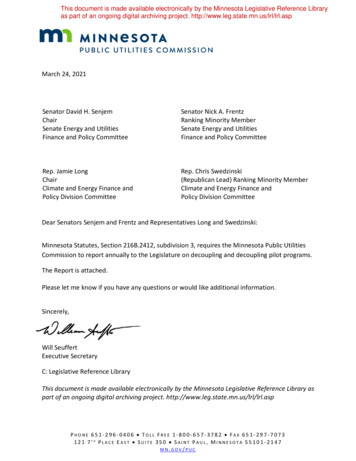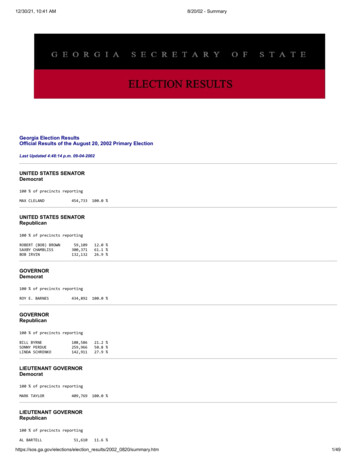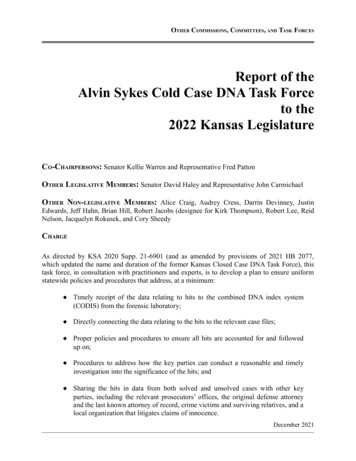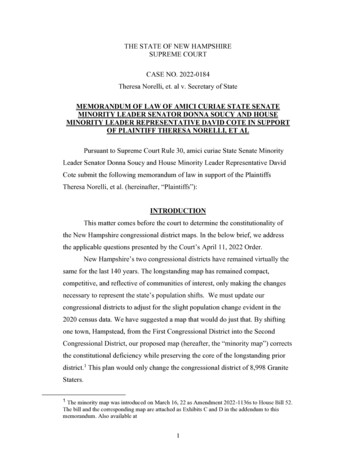
Transcription
This document is made available electronically by the Minnesota Legislative Reference Libraryas part of an ongoing digital archiving project. http://www.leg.state.mn.us/lrl/lrl.aspMarch 24, 2021Senator David H. SenjemChairSenate Energy and UtilitiesFinance and Policy CommitteeSenator Nick A. FrentzRanking Minority MemberSenate Energy and UtilitiesFinance and Policy CommitteeRep. Jamie LongChairClimate and Energy Finance andPolicy Division CommitteeRep. Chris Swedzinski(Republican Lead) Ranking Minority MemberClimate and Energy Finance andPolicy Division CommitteeDear Senators Senjem and Frentz and Representatives Long and Swedzinski:Minnesota Statutes, Section 216B.2412, subdivision 3, requires the Minnesota Public UtilitiesCommission to report annually to the Legislature on decoupling and decoupling pilot programs.The Report is attached.Please let me know if you have any questions or would like additional information.Sincerely,Will SeuffertExecutive SecretaryC: Legislative Reference LibraryThis document is made available electronically by the Minnesota Legislative Reference Library aspart of an ongoing digital archiving project. http://www.leg.state.mn.us/lrl/lrl.aspPHONE 651-296-0406 TOLL FREE 1-800-657-3782 FAX 651-297-7073121 7TH PLACE EAST SUITE 350 SAINT PAUL, MINNESOTA 55101-2147MN.GOV/PUC
Report on Decoupling and Decoupling PilotPrograms under Minnesota Statutes,Section 216B.2412March 24, 20211
Required General Legislative Report InformationMinnesota Public Utilities Commission121 7th Place East, Suite 350Saint Paul, Minnesota 55101-2147mn.gov/pucMinnesota Statutes, Section 216B.2412, subdivision 3 requires the Minnesota Public UtilitiesCommission (Commission) to report annually to the Legislature on decoupling and decouplingpilot programs.Pursuant to Minnesota Statutes, Section 3.197, the Minnesota Public Utilities Commission’sestimated costs for preparing this Report are minimal as most of the information is developedin the normal course of business. Special funding was not appropriated for the costs ofpreparing this report.To request this document in another format such as large print or audio, call 651.296.0406 (voice).Persons with a hearing or speech impairment may call using their preferred TelecommunicationsRelay Service or email consumer.puc@state.mn.us for assistance.2
BackgroundMinnesota Statutes, Section 216B.2412, enacted in 2007, requires the Minnesota PublicUtilities Commission (Commission) to establish criteria and standards for the decoupling ofenergy sales from revenues and establish at least one pilot program for a rate-regulated naturalgas or electric utility.Statutory Definition of DecouplingSubdivision 1 of that section defines decoupling as: a regulatory tool designed to separate a utility’s revenue from changes in energysales. The purpose of decoupling is to reduce a utility’s disincentive to promoteenergy efficiency.In other words, decoupling is intended to make a regulated utility indifferent to the risk of lostrevenues resulting from fewer energy sales due to customer or utility investments in costeffective energy efficiency and other resources that reduce total customer energyconsumption.Statutory Requirements - Decoupling Program Criteria and Pilot ProgramsSubdivisions 2 and 3 of that section go on to provide the following:Subd. 2. Decoupling criteria. The commission shall, by order, establish criteriaand standards for decoupling. The commission may establish these criteria andstandards in a separate proceeding or in a general rate case or other proceedingin which it approves a pilot program, and shall design the criteria and standardsto mitigate the impact on public utilities of the energy-savings goals under section216B.241 without adversely affecting utility ratepayers. In designing the criteria,the commission shall consider energy efficiency, weather, and cost of capital,among other factors.Subd. 3. Pilot programs. The commission shall allow one or more rate-regulatedutilities to participate in a pilot program to assess the merits of a rate-decouplingstrategy to promote energy efficiency and conservation. Each pilot program mustutilize the criteria and standards established in subdivision 2 and be designed todetermine whether a rate-decoupling strategy achieves energy savings. On orbefore a date established by the commission, the commission shall require electricand gas utilities that intend to implement a decoupling program to file adecoupling pilot plan, which shall be approved or approved as modified by thecommission. A pilot program may not exceed three years in length. Any extensionbeyond three years can only be approved in a general rate case, unless that3
decoupling program was previously approved as part of a general rate case. Thecommission shall report on the programs annually to the chairs of the House ofRepresentatives and senate committees with primary jurisdiction over energypolicy.2020 Decoupling-related Activity and Commission ActionsIntroductionIn response to the statutory requirement and after several stakeholder workshops and roundsof written comments, on June 19, 2009, the Commission issued its ORDER ESTABLISHINGCRITERIA AND STANDARDS TO BE UTILIZED IN PILOT PROPOSALS FOR REVENUE DECOUPLING.1CenterPoint Energy (CenterPoint) implemented the first pilot decoupling program which is stillactive. Minnesota Energy Resources (MERC) and Great Plains Natural Gas Co. (Great Plains)also currently have active decoupling programs. Northern States Power Company d/b/a XcelEnergy (Xcel) operated an electric decoupling pilot which expired on December 31, 2019;however, Xcel has indicated that it plans to propose a new pilot in its next general rate casethat is expected to be filed in the fall of 2021.Otter Tail Power Company (Otter Tail, OTP) as part of its November 2020 rate case filing,2proposed a full decoupling pilot that, if approved, would go into effect in conjunction withimplementation of final rates. A Commission decision and order in the rate case is expected inlate 2021.The Commission has not required or authorized pilot decoupling programs for MinnesotaPower, Xcel Energy’s gas utility or Greater Minnesota Gas.On July 1, 2020, as directed in prior Commission actions, the Minnesota Department ofCommerce, Division of Energy Resources (Department, DOC) filed a proposal for streamliningannual decoupling reports for all decoupled utilities.1In the Matter of Commission Investigation Into the Establishment of Criteria and Standards for the Decoupling ofEnergy Sales from Revenues, Docket No. E, G-999/CI-08-132.2In the Matter of the Application by Otter Tail Power Company for Authority to Increase Rates for Electric Servicein the State of Minnesota, Docket No. E-017/GR-20-719.4
CenterPoint Energy3On June 9, 2014, the Commission issued its FINDINGS OF FACT, CONCLUSIONS OF LAW, ANDORDER (2014 CenterPoint Order) in CenterPoint Energy’s 2013 General Rate Case.4 The 2014CenterPoint Order authorized a three-year, full-decoupling pilot program beginning on July 1,2015 that encompassed all customer classes except for market-rate customers, and requiredCenterPoint to file an annual evaluation report. The pilot has subsequently been extended,most recently in CenterPoint’s 2019 Rate Case.5CenterPoint Energy’s 2020 Decoupling Evaluation ReportOn September 1, 2020, CenterPoint submitted its fourth annual report for the evaluationperiod of July 1, 2019 through June 30, 2020.6 For the evaluation period, CenterPoint undercollected 904,565. Additionally, since revenue decoupling mechanism (RDM) recoveries arevolumetric, and when combined with the Company’s previous year’s adjustment of 768,399,this resulted in net total surcharges of 1,672,964. None of the decoupled customer classeswere subject to the 10% cap on decoupling surcharges. A summary of amounts to berecovered, by customer class, is provided in Table 1:Table 1 - Decoupling Adjustment Balance through June 30, 2020DecouplingAdjustmentAdjustmentMade toBalance throughReflect 10%Prior PeriodClassJune 30, 2020CapBalance( 351,980) 409,333Residential 191,769( 36,908)Commercial A 473,413 15,819Commercial & Industrial B 950,267 581,776Commercial & Industrial C( 41,979)( 143,731)SVDF A( 152,495)( 130,878)SVDF B( 269,156) 41,107LVDF 104,725 31,881Large Volume General Firm 904,565 0 768,399Total3AdjustedBalance 57,353 154,861 489,232 1,532,043( 185,710)( 283,373)( 228,049) 136,606 1,672,964CenterPoint Energy Resources Corp. d/b/a CenterPoint Energy Minnesota Gas (CenterPoint Energy orCenterPoint).4In the Matter of an Application by CenterPoint Energy Resources Corp. d/b/a CenterPoint Energy Minnesota Gasfor Authority to Increase Natural Gas Rates in Minnesota, Docket No. G-008/GR-13-316.5ORDER ACCEPTING AND ADOPTING AGREEMENT SETTING RATES, AND INITIATING DEVELOPMENT OFCONSERVATION PROGRAMS FOR RENTERS, In the Matter of the Application by CenterPoint Energy ResourcesCorp., d/b/a CenterPoint Energy Minnesota Gas for Authority to Increase Natural Gas Rates in Minnesota, DocketNo. G-008/GR-19-524 (March 1, 2021)6In the Matter of the Petition of CenterPoint Energy Resources Corp., d/b/a CenterPoint Energy Minnesota Gas(CenterPoint Energy) for Acceptance of its Annual Revenue Decoupling Report for the One-year Period Ending onJune 30, 2020 and Approval of its Revenue Decoupling Mechanism Rate Adjustment, Docket No. G-008/M-20-7045
Adjustment factors and estimated monthly impact for CenterPoint’s decoupled classed aresummarized in Table 2.Table 2 - Decoupling Adjustment Factors and Average Monthly ImpactDecouplingAverageAverage MonthlyAdjustment perMonthlyDecouplingClassThermUse (in Therms) Adjustment ( )Residential 0.0000875 0.01Commercial A 0.0065369 0.45Commercial & Industrial B 0.00814250 2.04Commercial & Industrial C 0.004051,520 6.16SVDF A( 0.00398)3,900( 15.52)SVDF B( 0.00993)13,900( 138.03)LVDF( 0.00146)38,900( 56.79)Large Volume General Firm 0.0038953,800 209.28As shown in Table 3, and according to the Department, CenterPoint Energy’s 2019 energysavings achievements fell from the high of 2017 but increased compared to 2018 and 2016,making 2019 the second highest year of savings in the Company’s decoupling history. All ofCenterPoint’s customer classes had higher energy savings in 2019 compared to the average ofthe pre-decoupling years 2007-2009.Table 3 – CenterPoint Historical First-Year CIP Energy Savings (Dth) by Rate ClassCommercial & Industrial (C&I)Year/PeriodResidentialC&I A2007-09Average201520162017201820192019 PercentChange From2007-09C&l BC&I CC&I 5451,980,5342,020,148247%156%279%104%81%134%6
Table 4 below quantifies how much each customer category contributed to CenterPoint’senergy savings increase between 2019 and the 2007-2009 average and indicates that, in termsof first-year Dth savings, the commercial and industrial customer segments combined providedthe largest increase in energy savings, although the residential sector is very close.Table 4 – Comparing 2019 CenterPoint CIP Energy Savings For All Classes with Average of2007-2009 CIP Energy Savings (Dth)Commercial & IndustrialYear/PeriodResidentialEnergy SavingsIncrease (Dth)Energy SavingsIncrease asPercentage ofTotal IncreaseC&I OtherOverallProgramC&I AC&I 7%1.5%5.2%15.9%30.7%100.0%Table 5 below shows that CenterPoint’s first-year energy savings as a percent of retail salesincreased from 0.54 percent in 2007 to a high of 1.87 percent in 2017 before falling to itscurrent level of 1.43% percent, a slight increase over 2018.Table 5 – CenterPoint CIP Energy Savings as a Percent of 10-Year Weather-Normalized SalesCIP Plan Period2007-2008 Biennial PeriodExtension of 2007-2008 Biennial2010-2012 Triennial Period2013-2015 Triennial PeriodExtension of 2013-2015 Triennial2017-2019 Triennial PeriodYearApplicable Three-YearAverage 10-YearWeather NormalizedSales 7AnnualEnergySavings 980,5342,020,149EnergySavings as aPercent 6%1.47%1.87%1.40%1.43%
The Department, as in previous years, attributed CenterPoint’s energy savings to the followingfactors: the level of first-year energy savings;the different lifetimes of the mix of energy savings achieved each year (for example,large commercial and industrial projects generally have longer lifetimes; even ifCenterPoint achieved the same first-year energy savings in two years, the lifetimeenergy savings for CIP achievements associated with one of those years can be higher ifthat year’s achievements have a higher concentration of long lifetime projects); andchanges in lifetime assumptions between triennial CIPs (e.g., the assumed lifetime forbehavioral change projects is lower now than when first introduced).The Department noted that the third factor makes it difficult to compare changes in lifetimeenergy savings between triennial CIPs. However, based on the assumptions used at the time foreach CIP triennial, CenterPoint’s 2019 lifetime energy savings were 98 percent higher than theCompany’s average lifetime energy savings from 2007 through 2009. To put CenterPoint’senergy savings in context, CenterPoint’s 2019 lifetime energy savings were 23.0 million Dth,enough savings to provide natural gas service to almost 260,090 residential customers for ayear.On March 4, 2021, the Commission met to consider CenterPoint’s 2020 Decoupling EvaluationReport and voted to accept the Department’s recommendation to approve the 2020 Reportand its related decoupling adjustments. The Commission issued its Order in this matter onMarch 8, 2021.7Minnesota Energy Resources Corporation (MERC)On July 13, 2012, the Commission issued its FINDINGS OF FACT, CONCLUSIONS, AND ORDER(2012 MERC Order) in MERC’s 2010 general rate case.8 As part of the 2012 MERC Order, theCommission authorized a three-year pilot “full” revenue decoupling mechanism (RDM) thatencompassed the Residential and the Small Commercial and Industrial customer classes.MERC’s revenue decoupling pilot program became effective on January 1, 2013 with theimplementation of rates authorized as a result of the 2010 general rate case.7Order, In the Matter of the Petition of CenterPoint Energy Resources Corp., d/b/a CenterPoint Energy MinnesotaGas (CenterPoint Energy) for Acceptance of its Annual Revenue Decoupling Report for the One-year Period Endingon June 30, 2020 and Approval of its Revenue Decoupling Mechanism Rate Adjustment, Docket No. G-008/M-20704 (March 8, 2021)8In the Matter of the Application of Minnesota Energy Resources Corporation for Authority to Increase Rates forNatural Gas Service in Minnesota, Docket No. G-011/GR-10-977.8
MERC’s pilot revenue decoupling program was initially authorized to run through December 31,2015; however, the pilot has been extended several times, most recently through December31, 2022.9MERC’s 2019 Decoupling Evaluation Report – Docket 20-332On February 28, 2020 MERC submitted its Annual Adjustment Calculation and, on May 8, 2020,MERC submitted its sixth Annual Evaluation, encompassing the period of January 1 toDecember 31, 2019.10As shown in Table 6, the 2019 RDM adjustment calculation resulted in a 3,994,174 refund forthe Residential Class. Since the Company recovers surcharges/refunds on a volumetric basis, atrue up of the previous year’s adjustment is also necessary to make the Company andratepayers “whole”; therefore, the coming year’s adjustment includes 2017 true-ups for theResidential Class and the no-longer-decoupled Small Commercial and Industrial Class.Residential customers will receive a 2017 true-up refund of 399,861 for a total combinedrefund of 4,394,036. Small Commercial & Industrial customers will get a final 40,447surcharge.Table 6: MERC Revenue Decoupling Mechanism Adjustment Calculationfor Rates Effective March 1, 2019ResidentialSmall C&I2019 RDM Surcharge/(Refund)( 3,994,174)Not Applicable2017 Reconciliation Adjustment( 399,861) 40,447Total Surcharge/(Refund)( 4,394,036) 40,4479Findings of Fact, Conclusions, and Order, In the Matter of the Application of Minnesota Energy ResourcesCorporation for Authority to Increase Rates for Natural Gas Service in Minnesota, Docket No. G-011/GR-17-563(December 26, 2018)10In the Matter of 2019 Annual Revenue Decoupling Evaluation Report and Revenue Decoupling MechanismAdjustment Calculation, Docket No. G-011/M-20-3329
As shown in Table 7, the average annual refund for Residential customers will be 20.89 andthe average annual surcharge for Small Commercial & Industrial customers will be 4.45.Customer ClassResidentialSmall C&ITable 7: Estimated Rate and Bill Impacts fromProposed RDM Factors Effective March 1, 2019Monthly BillRDM per ThermImpact of RDMSurchargeAverage UsageSurcharge( 0.02391)874( 1.74) 0.00445999 0.37AnnualEstimated BillImpact( 20.89) 4.45Table 8 compares MERC’s pre-decoupling (2010-2012) energy savings with the Company’s lastfive years of post-decoupling (2015-2019) energy savings. The Department noted that MERC’saverage post-decoupling first-year dekatherm (Dth) savings are higher than the average predecoupling energy savings, both when measured as an annual amount and as a percent of retailsales. Further, the Department calculated that average post-decoupling Dth savings are eightpercent higher than the average pre-decoupling Dth savings. Although MERC’s 2019 Dthsavings are lower than its 2018 Dth savings, the 2019 Dth savings are still 8 percent higher thanthe average pre-decoupling Dth savings.Post-DecouplingPreDecouplingTable 8: Comparing MERC’s Last Five Years of Total Post-Decoupling CIP Savings toThree Years of Total Pre-Decoupling CIP SavingsNon-CIP-Exempt Energy SavingsFirst-YearYearRetail Salesas Percent ofEnergy Savings(Dth)Retail 469,3350.96%(2013-2019)10
Post-DecouplingPreDecouplingTable 9 below compares MERC’s lifetime energy savings by residential and customer classesand total classes (combined residential and customer classes.)Table 9: Comparing MERC’s Lifetime Savings AchievementsFor Post-Decoupling (2015-2019) to Pre-Decoupling (2010-2012)Residential LifetimeC&I Lifetime SavingsTotal LifetimeYearSavings (Dth)(Dth)Savings erage3,431,0793,739,8267,170,905(2013-2019)The Department, when comparing the last five years’ post-decoupling average to the three predecoupling years, pointed out that: MERC’s residential lifetime Dth savings increased 6 percent;MERC’s C&I lifetime Dth savings increased 12 percent; andMERC’s total lifetime Dth savings increased 9 percent.Also, when comparing only 2019 to the pre-decoupling average: MERC’s residential lifetime Dth savings increased 2 percent;MERC’s C&I lifetime Dth savings increased 7 percent; andMERC’s total lifetime Dth savings increased 5 percent.Consistent with its conclusion in previous years, the Department stressed that:. . . there are many components of Minnesota’s regulatory structure that incentutility investment in encouraging its customers to invest in energy conservation.Given all of the elements of a favorable climate for IOU investment in energyconservation, it is not possible to state that one of the parts—revenuedecoupling—is responsible for a specific amount of an IOU’s commitment toenergy savings. However, the Department’s review of MERC’s CIP energy savingsindicates that the Company’s energy savings are higher post-revenue decouplingthan pre-revenue decoupling.11
On March 4, 2021, the Commission met to consider MERC’s 2019 Decoupling Evaluation Reportand voted to accept the Department’s recommendation to approve the 2019 Report and itsrelated decoupling adjustments. The Commission issued its Order in this matter on March 8,2021.11Xcel Energy - ElectricXcel’s electric decoupling pilot expired on December 31, 2019; however, Xcel has indicated thatit plans to propose a new pilot in its rate case which is expected to be filed in the fall of 2021.Great Plains Natural Gas Co.On September 6, 2016, the Commission issued its FINDINGS OF FACT, CONCLUSIONS, ANDORDER in Great Plains’ 2015 general rate case.12 In this Order, the Commission authorized,effective January 1, 2017, a three-year pilot “full” revenue decoupling mechanism (RDM) that,except for Flexible Rate customers and one Large Interruptible customer, applies to all GreatPlains’ customers. The Commission’s approval of Great Plains’ RDM requires the Company tofile an annual Revenue Decoupling Evaluation. The pilot has subsequently been extendedthrough December 31, 2021.13Great Plains’ 2019 Decoupling Evaluation Report – Docket 20-335On February 28, 2020, Great Plains filed its third annual Evaluation, encompassing the period ofJanuary 1 to December 31, 2019. On May 1, 2020, Great Plains filed its CIP Supplement to theRevenue Decoupling Mechanism Rates and Decoupling Evaluation Report for Year 3 of PilotProgram.As summarized in Table 10, Great Plains over-collected and will refund a net amount of 192,225. However, for Large Interruptible - S85 & S82 Class, the 10% cap applies, whichfurther increases the 2019 amount to be refunded to 209,756. Additionally, the previousyear’s true-up resulted in an extra 89,482 to be refunded. In total, decoupled classes willreceive in aggregate net refunds totaling 299,238. Table 10 summarizes all refunds andadjustments, by class.11Order, In the Matter of 2019 Annual Revenue Decoupling Evaluation Report and Revenue DecouplingMechanism Adjustment Calculation, Docket No. G-011/M-20-332 (March 8, 2021)12In the Matter of the Petition by Great Plains Natural Gas Co., a Division of MDU Resources Group, Inc., forAuthority to Increase Natural Gas Rates in Minnesota, Docket G-004/GR-15-879.13In its October 26, 2020 Order, In the Matter of the Petition by Great Plains Natural Gas Co., a Division ofMontana-Dakota Utilities, Co., for Authority to Increase Natural Gas Rates in Minnesota, Docket G-004/GR-19-511,the Commission adopted the ALJ’s recommendation to extend Great Plains’ pilot through December 31, 2021.12
Table 10 - Great Plains 2019 Decoupling AdjustmentsRate ClassResidential Rate - N60Residential Rate - S60Firm General - N70Firm General - S70Small Interruptible - N71 & N81Small Interruptible - S71 & S81Large Interruptible - N85 & N82Large Interruptible - S85 & S82Total UnderI(Over) oupling to Reflect DecouplingPeriodAdjustment10% CapAdjustment Adjustment( 86,791) 0( 86,791)( 60,290)( 111,198) 0 ( 111,198)( 53,713)( 44,587) 0( 44,587)( 12,790)( 20,880) 0( 20,880) 28,030 37,348 0 37,348( 14,561)( 39,573) 0( 39,573)( 145) 1,871 0 1,871 8,445 71,585( 17,531) 54,054 15,542( 192,225)( 17,531) ( 209,756)( 89,482)NetBalance tobeAdjusted Surchargeor(Refund)( 147,081)( 164,911)( 57,377) 7,150 22,787( 39,718) 10,316 69,596( 299,238)Table 11 summarizes the monthly average surcharge or (refund) expected for each customerclass.Table 11: Monthly Average Surcharge or (Refund) for an Average Customer by ClassDecouplingAverage MonthlyAverage MonthlyAdjustment per DthUse in DthSurcharge orCustomer Class(Refund)Residential – N60 (0.2038)7.0( 1.43)Residential – S60 (0.2047)6.5( 1.33)Firm General – N70 (0.1244)30.2( 3.76)Firm General – S70 0.009037.5 0.34Small IT – North 0.0795367.6 29.22Small IT – South (0.1182)400.1( 47.29)Large IT – North 0.03603,413.1 122.87Large IT – South 0.078812,266.3 966.5813
In reviewing Great Plains’ energy savings, the Department noted, as shown in Table 12, that thelow-income segment produced the least amount of first-year savings, while the commercial andindustrial segment produced the most variable first year (i.e. from one year to the next)savings. The Department attributed this variability, in large part, to the presence or absence ofcustom projects for the commercial and industrial segment.Table 12: Great Plains’ First Year CIP Energy Savings (Dekatherms – Dth)by Customer Segment, 2013-2019Residential & SmallLowCommercial &YearCommercialIncomeIndustrialOverall ,08320199,6211,0272,52713,175The Department added that, as shown in Table 13, Great Plains first year energy savingsaveraged 40,205 dekatherms during the four-year pre-RDM period; whereas, during the threeyear Pilot, first year energy savings declined to an average of 20,945 dekatherms per year. TheDepartment pointed out that, in 2019, the Company’s first year energy savings were 13,175 Dthwhich is equivalent to a 67.2 percent decrease from the Pre-RDM average of 40,205 Dth.Furthermore, when compared to post-decoupling, Great Plains’ pre-decoupling savings werehigher for every customer segment.Table 13: Average Annual First-Year Savings by Customer Segment,Pre-RDM, RDM Years 1-3, and RDM Year 3Annual First Year Savings (Dth)2013-2016 Average2017-2019 Average2019 Evaluation YearCustomer Segment(Pre-RDM Pilot)(RDM Pilot Years 1-3)(RDM Year 3)Residential & Small11,0918,9429,621CommercialLow Income6885661,027Commercial &28,42711,4372,527IndustrialOverall Program40,20520,94513,17514
The Department observed that, as shown in Table 14, Great Plains’ energy savings performancedepends on the availability of custom projects for the Commercial & Industrial customersegment. When custom projects are removed from the analyses, the post-RDM energy savingsdecreases are less 20132019Table 14: Savings (Dth) and Impacts (%) of Great Plains’ Custom Projectson the Commercial/Industrial Segment and Overall ProgramCommercial andOverallCommercial &Industrial withoutProgramIndustrial TotalCustom ProjectsCustom ProjectsPercentagePercentagePercentageof Overallof Overallof OverallProgramProgramProgramSavings ,52719%31,95121,14551%4,4191521%
Further, the Department stated that, at no point since 2013, either before or after theimplementation of the RDM Pilot, has Great Plains reached the 1.5% energy savings goal in theCIP Statute. Figure 1, below, shows Great Plains’ CIP energy savings as a percent of weathernormalized retail sales for years 2013-2019.Figure 1: Great Plains’ First-Year CIP Energy Savings as a Percentage of WeatherNormalized Sales (%), 2013-2019, with Pre-RDM Average and RDM Years 1-3 uation 2017-2019Year 2019 Average(RDM Pilot (RDM PilotYear 3)Years 1-3)Great Plains’ 2019 Rate Case – Docket 19-511On October 26, 2020, the Commission issued its Findings of Fact, Conclusions, and Order inGreat Plains’ 2019 rate case.14 That Order adopted most of the ALJ’s recommendations,including the one that extended the Company’s RDM through December 31, 2021.14In the Matter of the Petition by Great Plains Natural Gas Co., a Division of Montana-Dakota Utilities, Co., forAuthority to Increase Natural Gas Rates in Minnesota, Docket No. G-004/GR-19-51116
Otter Tail Power CompanyOtter Tail Power Company – Docket No. 20-719As part of its November 2, 2020 initial rate case filing, Otter Tail proposed a full-decoupling pilotto be implemented with final rates.15 The pilot would apply to the following classes: 9.01 – 9.03 – Residential, Residential Demand Control, Farm10.01 – 10.03 Small General Service, General Service, General Service Time of Use10.04 – Large General Service10.05 – Large General Service Time of Day11.02 – Irrigation Option 1 (non-time of use) and Option 2 (time of use)11.05 – Municipal pumpingWhen compared to other approved RDM pilots, the Otter Tail proposal takes a novel approachin that for all the classes except for 10.04 and 10.05, the proposed decoupling adjustments arebased on the number of meters rather than the number of customers. Otter Tail also proposedthat the total aggregated amount of the RDM deferral be pooled and then the net amount beallocated back to the customer classes based on each customer class’s approved forecastedsales. The details and merits of Otter Tail’s RDM will be developed in the rate case’s record. Afinal Commission decision on Otter Tail’s rate case is expected in late 2021.Streamlining of Annual Revenue Decoupling Evaluation ReportsIn its Comments on MERC’s 2018 Decoupling Evaluation Report, the Department stated: In recent years, the Department has primarily focused on the part of theevaluation report that focuses on the utilities’ CIP energy savings achievementsbecause Minnesota Statutes § 216B.2416, subd. 1 states that the purpose ofdecoupling is to reduce a utility's disincentive to promote energy efficiency. Noother party has been commenting
strategy to promote energy efficiency and conservation. Each pilot program must utilize the criteria and standards established in subdivision 2 and be designed to determine whether a rate-decoupling strategy achieves energy savings. On or before a date established by the commission, the commission shall require electric
![No, David! (David Books [Shannon]) E Book](/img/65/no-20david-20david-20books-20shannon-20e-20book.jpg)









